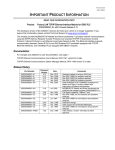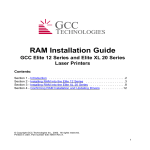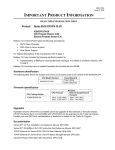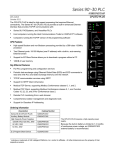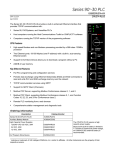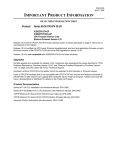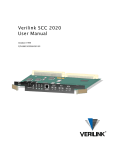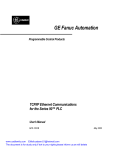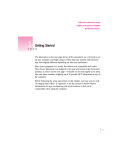Download Apple Computer Welding System aix appletalk services User's Manual
Transcript
K Update to “Using AIX, AppleTalk Services, and Mac OS Utilities on the Network Server” and “Setting up the Network Server” This document provides supplemental information to the AIX, AppleTalk Services, and The Network Server quick reference card, and the technical specifications contained in Setting Up the Network Server. It also provides additional hardware options, safety and troubleshooting information, and a list of optional upgrades available for your Network Server 500 and 700 models. Update to AIX, AppleTalk Services, and the Network Server If you are using a one-button mouse with the Network Server running AIX™, use the single button to correspond to the left mouse button on a three-button mouse. Press the Caps Lock key and the Left arrow key to correspond to the middle button. Press Caps Lock key and the Right arrow key to correspond to the right button. To correspond to this button on a three-button mouse: Use this key combination left mouse button middle mouse button right mouse button the mouse button Caps Lock key and the Left arrow key Caps Lock key and the Right arrow key Updated Technical Specifications in Setting Up the Network Server Processor m PowerPC™ 604 processor at 132 or 150 megahertz (MHz) or PowerPC 604e at 200 MHz m 32 kilobytes (K) of on-chip cache with the PowerPC 604 processor, or 64 kilobytes (K) of on-chip cache with the PowerPC 604e processor Memory m A minimum of 32 megabytes (MB) of 60 nanosecond (ns) parity DRAM, expandable to a maximum of 512 MB through 8 DIMM sockets m 4 MB read-only memory (ROM) m 8K of nonvolatile parameter memory m 512K of static RAM used as a Level 2 cache for the PowerPC processor on the 500 model; 1 MB on the 700 model Disk drives m Apple SuperDrive 1.4 MB high-density floppy disk drive m Optional internal Apple SCSI-2 Fast/Wide hard disk drive m Internal 5.25-inch CD-ROM player m Optional internal 3.5-inch DDS-2 DAT drive m Optional internal 8 mm 20/40 GB tape drive m Up to nine half-height or smaller SCSI devices (seven on the 500 model) may be connected internally (seven drives through the front drive bays, and on the 700 model, two drives in the rear-mounted internal bracket) Full-height devices can be accommodated by using two of the front drive bays. 2 Monitors This table shows the image size for monitors connected to the monitor port, along with the number of colors or grays supported: Hz Resolution Colors or grays 60 70 72 60 72 75 60 72 75 640 x 480 640 x 480 640 x 480 800 x 600 800 x 600 800 x 600 1024 x 768 1024 x 768 1024 x 768 256 256 256 256 256 256 256 256 256 Interfaces m One Apple Desktop Bus (ADB) port that supports a keyboard and mouse m One video port that supports color and monochrome monitors of various resolutions, up to 1024 by 768 m Internal expansion slots that support six PCI expansion cards m Built-in Apple Ethernet AAUI connector for connecting to 10 megabits per second (Mbps) Ethernet networks m Three SCSI interfaces that support up to 16 SCSI devices (7 internal and 7 external on the 500 model, 9 internal and 7 external on the 700 model; internal buses are SCSI-2 Fast/Wide, external bus is SCSI-1) m Two serial ports m Microphone (in) port m Speaker (out) port 3 A/C line input m Line voltage: 100–240 volts AC, RMS single phase, automatically configured m Frequency: 50–60 Hz m Power: 708 watts maximum Power supply m Single 325-watt on the 500 model; one or two 425-watt, hot-swappable supplies on the 700 model Current type 500 model 700 model + 3.3 V* + 5 V* +12 V (normal) +12 V (start up) –12 V 25.0 A 28.0 A 11.0 A 18.0 A (12 seconds maximum) 100 mA 50.0 A 44.0 A 13.0 A 18.0 A (12 seconds maximum) 100 mA *+3.3 and +5 power outputs are traded off; total power for both not to exceed 180 watts for the 500 model, 260 watts for the 700 model. Clock/Calendar m CMOS custom circuitry with long-life lithium battery WARNING If the clock begins to lose accuracy, see an Apple-authorized dealer or service provider for a battery replacement. Do not attempt to replace the clock battery yourself. Keyboard m Supports Apple ADB keyboards (an extended keyboard is recommended) 4 Mouse m Supports all models of the ADB mouse m Supports true hardware three-button mouse DRAM configurations DRAM is provided in packages called Dual Inline Memory Modules, or DIMMs. Your server can work with any of several DRAM configurations, depending on the density of the DRAM chips that are mounted on the DIMMs. It supports a range of DIMMS from 8 MB to 128 MB. The 168-pin parity DIMMs used in the Network Server are available from Apple in sizes of 8, 16, and 32 MB pairs, enabling you to increase Network Server memory by 16, 32, or 64 MB. Your server can have a maximum of 512 MB of memory. IMPORTANT Parity DIMMs must be 72-bit wide, 168-pin fast-paged mode, 60-nanosecond (ns) RAM access time or faster. Parity DRAM must support byte writes. SIMMs and DIMMs from some Macintosh computers will not work in the Network Server. The parity DIMMS should be installed in matched pairs (for example, two 16 MB DIMMs, one in slot 1A, the other in slot 1B) for maximum performance. Nonparity DRAM that is 168-pin fast-page mode, 70-nanosecond access time or faster will work in the Network Server; however, if there is any nonparity DRAM installed, all server parity checking is disabled and performance is reduced. Consult an Apple-authorized dealer or service provider for information and upgrades. Power requirements Apple Desktop Bus m Maximum power draw for all ADB devices: 500 milliampere (mA) m Apple mouse draws up to 10 mA m Keyboard draws 25–80 mA (varies with keyboard model used) Note: It is recommended that you connect no more than three ADB devices to the Network Server. 5 Expansion cards and devices If you add a PCI expansion card or an internal SCSI device to your server, make sure the component doesn’t exceed its maximum power allowance from the different voltage sources. No single PCI card should exceed the 25 watt limit of the PCI Revision 2.1 specification. Follow these guidelines. Network Server Voltage Current Total power 500 model +3.3 V 10.0 A Not to exceed 50.0 watts in any combination +5 V +12 V 10.0 A 2.0 A +3.3 V 18.0 A +5 V +12 V 18.0 A 2.0 A 700 model Not to exceed 90.0 watts in any combination For SCSI devices, the average (thermal) power consumption per drive bay is 1.1 amps at +5 volts and 1.3 amps at +12 volts. Apple recommends that drives be configured for spin-up on command or delay. Size and weight Weight Height Width Depth 622 mm 24.5 in. 419 mm 16.5 in. 257 mm 18 in. 33 mm 1.3 in. 61.7 mm 2.4 in. 107.3 mm 4.2 in. Main unit 40 – 44 kg* 84 – 92 lbs.* Mouse 0.10 kg 4 oz. *Exact weight varies depending on number and type of internal SCSI devices installed. 6 Updated hardware support The following hardware enhancements have been made to all models of the Network Server: m Support has been added for the Seagate 9 gigabyte (GB) hard drive and for 8x CD-ROM drives. m Support has been added for Ultra-SCSI drives. m Support has been added for external connection of differential devices to Symbios Logic PCI cards. m Ethernet performance and reliability have been improved. m Full PCI device driver binary compatibility has been achieved. m Common I/O subsystem support for FDDI, ATM, and Token Ring has been added. Additional safety information Observe the following safety measures to help safeguard your data and the Network Server itself: m Turn the power off before adding drives. Unless you have installed and are using the Network Server PCI RAID Disk Array card, always shut down the server and turn power off before replacing or adding drives. For more information about adding drives with RAID, check the Network Server PCI RAID Disk Array Card Administrator’s Guide. m Replace only one drive at a time. Do not insert more than one drive tray into the front drive bays at the same time. m Ensure proper ventilation. To ensure maximum airflow and cooling, don’t leave any drive trays out or panels open while the server is running. m Never use alcohol-style cleaning cartridges for tape drives. Always use Apple-approved cleaning cassettes or cartridges. 7 Additional troubleshooting Information Ethernet Follow these guidelines to eliminate or avoid Ethernet problems: m Connect an Apple PCI Ethernet card to only one network at a time. Although the card has three connectors, it should not be connected to more than one network. m Do not install an Apple PCI Ethernet card without connecting a network cable. If you configure an Apple PCI Ethernet card by assigning it an IP address or by enabling AppleTalk, the card attempts to determine which of the three possible media types is connected to it. If you have not connected a network cable, you will hear clicking sounds every few seconds. These clicking sounds continue until the cable is connected. Although this should cause no serious problems, the lack of a cable may cause long pauses during system startup, as the system attempts to contact other servers on the network. m For maximum performance, always install Ethernet cards beginning with the slot farthest away from the processor card—slot 6 before slot 5, and so on. Keyboard It is strongly recommended that you use an Apple Extended Keyboard or an equivalent third-party keyboard with all models of the Network Server. Monitors You must use a monitor with multiple scan support with the Network Server. Many older monitors do not work with the Network Server. 8 Available Peripherals The following accessory kits are now available for all models of the Network Server. Depending on the configuration you choose, some of these are preinstalled on your Network Server enclosure. The others can be purchased separately from your Apple-authorized Network Server dealer. Memory Upgrades m 16 MB Memory Upgrade Kit M4017Z/A m 32 MB Memory Upgrade Kit M4018Z/A m 64 MB Memory Upgrade Kit M4019Z/A Hard Disk Drives m 2 GB Fast/Wide SCSI Disk Drive and Tray M4022Z/A m 4 GB Fast/Wide SCSI Disk Drive and Tray M4023Z/A m 9 GB SCSI Disk Drive in Tray M5178Z/A The following hard disk drives are available for the Network Server 700 models only: m 2 GB Rear Disk Drive in Rear Mount Bracket M4818Z/A m two 4 GB Rear Disk Drives M4819Z/A Tape Drives m DAT-2 4 mm Tape Drive in Tray M4025Z/A m 8 mm Tape Drive in Tray M4026Z/A CD-ROM Drives m 4x CD-ROM Drive in Tray M4024Z/A The following CD-ROM drive is a standard feature of the Network Server 700/200. It is not currently available for other models: m 8x CD-ROM Drive in Tray 9 RAID m Network Server PCI RAID Controller Card M4030Z/A m Network Server External SCSI Cables for RAID Card M4031Z/A Network Cards m Apple PCI 100 Megabit Ethernet Card M3906Z/A m Apple PCI 10 Base T Ethernet Card M4709Z/A Other 10 m Redundant Power Supply M4035Z/A (Available for Network Server 700 models only) m 19" Rack Mount Kit M4036Z/A m SCSI Drive Adapter Kit M4028Z/A m SCSI Front Panel Bezel M4029Z/A © 1997 Apple Computer, Inc. All rights reserved. Apple, the Apple logo, Apple SuperDrive, AppleTalk, Mac, and Macintosh are trademarks of Apple Computer, Inc., registered in the U.S. and other countries. AIX is a registered trademark and PowerPC is a trademark of International Business Machines Corporation, used under license therefrom. 033-0547-A Printed in U.S.A.












